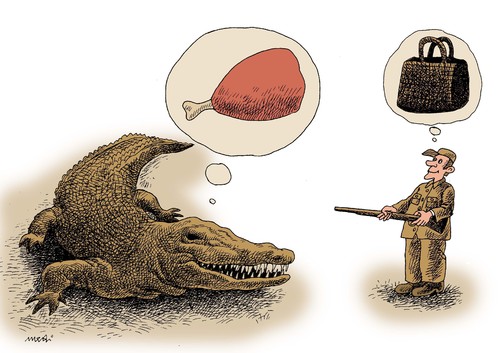
Florida's Shoot-To-Kill Order On Crocodile
A dangerous crocodile is on the loose near Miami - leading wildlife officials to issue a rare order to take down the reptile.
Florida wildlife officials have issued a rare shoot-to-kill order in the hunt for a young and potentially dangerous Nile crocodile on the loose near Miami.The Nile crocodile, which hails from Africa, can jump higher, run faster and grow to nearly 20 feet in length, several feet larger than its American cousin, and has a "nastier" temperament.
And while the American crocodile stays near saltwater like mangroves and estuaries, the Nile crocodile prefers freshwater, making it more likely to come in contact with humans.
Florida Fish and Wildlife Conservation Commission (FWC) officials said the Nile crocodile on the loose is thought to be around three feet long.
The commission is investigating where the crocodile came from, although experts said it most likely escaped "from a facility or a local breeder", probably as a hatchling.
Reptile expert and wrangler Joe Wasilewski said: "They get big. They're vicious. The animals are just more aggressive and they learn that humans are easy targets."
He described the American crocodile as a "gentle animal", adding: "They're more fish eaters. They don't consider humans a prey source."
Only FWC agents are authorised to kill the Nile crocodile at large. If it is caught alive, it will be put down.
A team of agents led by Frank Mazzotti, a University of Florida professor of wildlife ecology, has spent more than 1,000 hours searching by boats and on foot in the canal where the reptile was last seen.
Mr Mazzotti said the crocodile had been captured by someone in March, but was let loose, making it now "wary" of humans.
With reality TV shows glorifying reptile hunting and wrestling, anyone with a taste for adventure could interpret the ruling as a "licence to kill" and perhaps mistake the animals, according to Mr Wasilewski.
"They're going to shoot any crocodile or alligator. It will be the Wild West," he said.
Experts say most people cannot distinguish between a crocodile and an alligator, let alone differentiate between a Nile and American crocodile. Alligators are black and have broad, rounded snouts. Crocodiles are greyish and have narrow, tapered snouts.
Niles are dark green or black on top with dark row of spots on the sides. Americans have a lighter olive colour with pale yellow sides.
Official records on Nile crocodile sightings in Florida are sketchy, but there have been a handful.
Houdini, a nine-foot long, 10-year-old Nile crocodile, escaped from Billie Swamp Safari on Seminole Tribe reservation lands, but was recaptured a few years ago as part of the US cable TV show Swamp Men and relocated to a facility on Florida's west coast.
Seminole Tribe spokesman Gary Bitner said no other Nile crocodiles had been spotted on their reservation lands.
Mr Wasilewski said: "It's a couple of animals. I don't think it's a plague."












No comments:
Post a Comment